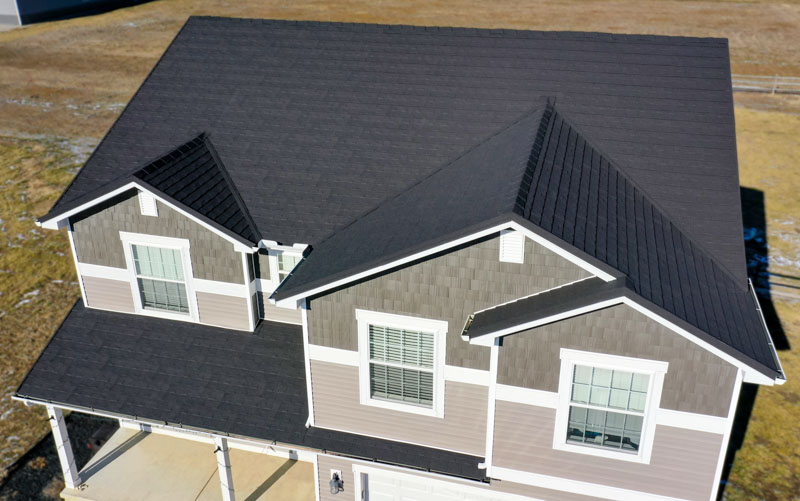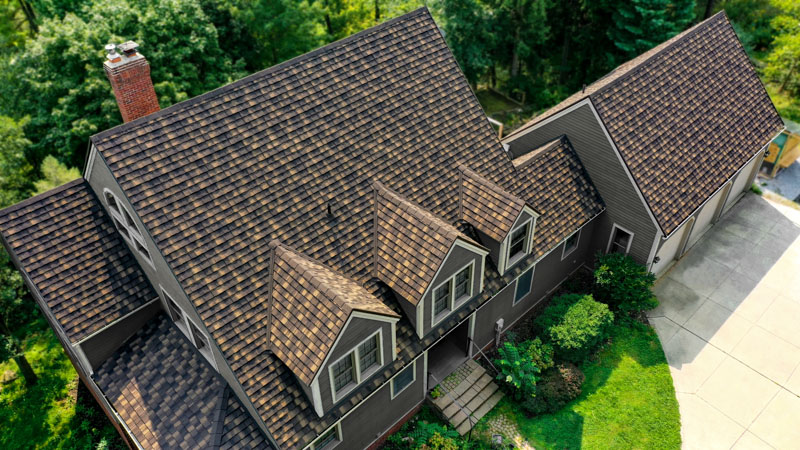In the mind of the Missouri public, metal roofing is for industrial buildings, which is more concerned with function than style. However, this perception could not be further from the truth – people use metal roofs for numerous reasons, from commercial buildings to apartments to a family home. Metal roofs offer durability, safety, and longevity for the buildings they protect.
St. Louis family houses are concerned with both functionality and style, which used to mean that metal roofs did not fit the desired image for suburban sub-developments. Shingles dominated the landscape with a few other options like shakes and tile, but metal roofs were not an option for many homeowners or developers.
Many people thinking of metal roofs do not realize how versatile and stylish they can be. They can come in many styles and colors, and imitate other materials. Their versatility allows for many design options, making metal roofs a smart choice for homeowners as well as commercial buildings.
Metal roofs are shedding their previous industrial image as their benefits are becoming more well-known. Metal roofs are becoming more and more popular for the family home, as well as local businesses. Before long, they could be the predominant form of roofing in America.
In This Article
Different Metal Roofing Materials
Today’s metal roofs are light years ahead of the corrugated sheets of the past. The industry is diverse and offers different styles, materials, colors, finishes and types. The assortment is so vast that contractors can top off any building in any climate with a metal roof and the end result will still look magnificent.
The first important choice is the material that will compose your roof. There are four principal options:
• Steel. The cheapest and strongest of the metals, steel is also the most recyclable. Due to its hail resistance and low cost, steel is the most common option in many areas of the country.
• Aluminum. Aluminum is not as strong as steel but is still a solid material. Its chief advantage is that it resists corrosion. For this reason, it is often the metal roof of choice for homes near the coast, where salt water corrosion can be an issue.
• Zinc. Zinc is a soft and expensive metal but very durable and highly recyclable. Zinc’s main disadvantage is that it tends to form a bluish/grey patina over time, and it is prone to chalking, which is when white residue forms on the surface.
• Copper. Even more expensive than zinc, copper is also a soft metal that is very recyclable and durable. However, hail and falling debris could harm the roof’s appearance. Copper expands and contracts more than most metals with temperature changes.
Style
After you settle on the kind of metal you want, you need to choose the style for your Missouri home. Metal roofing can imitate traditional roofing styles that can pass as the real thing unless you are right up close.
• Shingles. This is the classic American look. Contractors can install metal shingles using multiple methods.

• Tiles. For a more West Coast look, metal tiles can make you feel like you are in California or Arizona, particularly if your home is stucco.

• Shake. Wooden shake roofing is a look that many consider handsome, and now metal roofs can offer this aesthetic appeal.

Choosing the Finish
Finally, you need to choose the roof’s finish, which will impact its color, texture, and additional protection. The color can be virtually anything you can dream up. The relevant deciders are the style and color scheme of the house, the location it is in, and the climate.
There are several factors to consider when choosing the color of your metal roof. The first is obviously the appearance, but there are other concerns as well.
• Light colors will absorb less heat, which can be an advantage in warmer climates. However, colder areas may prefer a dark fini to soak up as much heat as possible.
• Consider that color mixes which rely heavily on one pigment, called saturated mixes, will more likely shift their color. A more balanced pigment relies less on one color and therefore is less likely to experience large color shifts.
The Metal Roof Difference
Many people wonder why they should opt for a metal roof to imitate shingling and shaking, when they could opt for the actual material. The truth is that there are many advantages to having a metal roof. The traditional roof’s chief advantage was its appearance, which goes better with suburban neighborhoods – but does not match metal roofs’ safety and durability.
Now that metal roofs can match other varieties in their style, shingles, tiles or shakes lose their biggest advantages. Even so, metal roofing does have some drawbacks. When deciding between metal roofing and traditional rooftops, you must consider the pros and cons for your St. Louis area.
• Lifespan. This is an easy win for metal roofs. Shingles will need replacing in 30 years. Metal roofs essentially last 50 years or more. Some metal roofs even come with a lifetime guarantee.
• Weight. Metal roofs are lighter than shingles, which surprises some people. This makes some aspects of installation easier and even means that, in some cases, roofers can install a metal roof on top of shingles. This practice also cuts down significantly on installation time and cost.
• Ambient temperature. In hot climates where the sun shines, metal roofs reflect back a lot of the sun’s heat, making air conditioning less expensive. In colder climates, shingles have a higher insulation value than metal roofs, but roofers can install metal sheets over foam insulation to create an equal advantage.
• Recycling. Most metal roofs are fully recyclable, which makes them a better “green” option. You cannot recycle shingles.
The Myth of the Metal Roof
Metal roofs have some bad press which turns out to be mostly untrue. You may have heard some of these before. Let’s dispel the myths.
• A metal roof will draw lightning. No, metal does not draw lightning. It conducts electricity but does not attract it. In fact, a metal roof acts as protection against lightning, because it disperses the electrical charge over a wide area, which weakens it.
• Metal roofs are noisy. This is often the case with a “barn-style” standing-seam roof, but metal shingles are no louder than a traditional roof. Additionally, extra insulation or upgraded underlayment can often mean that metal roof systems are quieter during rain.
• Hail damages metal roofs. Some roofs made of softer metals are susceptible to hail damage, however Erie’s stone-coated steel shingles are Class 4 hail rated and will neither dent nor break during a storm.
• You cannot walk on a metal roof. This is true in some select cases, but you can walk on many metal roofs without causing damage.
• A metal roof will leave your house cold in the winter. Your house will be warmer or colder based on your insulation. Your roof material has very little to do with it.
• A metal roof will heat your house up. Depending on factors like finish, color, texture and material, a metal roof reflects sunlight and can help keep your house cool in the summer. However, if you have a darker roof and heavier material, it can soak up the sun’s rays during winter time, which helps melt the snow off your roof.
It turns out that metal roofs are a good investment for your house, a good bargain in the long run, and can do the job just as well as, and in many instances, better than, shingles, shake, and tile. The only big drawback used to be the appearance, but this is decidedly not true for modern metal roofing.
Modern metal roofs are stylish and functional. Sometimes old perceptions take a while to fade away, but anyone who looks into the topic will be impressed by how far metal roofs have come. If you are looking to build or reroof your home, do yourself the favor of looking into metal roofs. They just might become your first choice.

